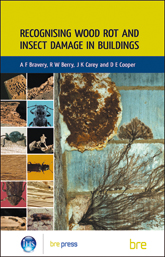Recognising wood rot and insect damage in buildings
--AtlantisDamp 13:39, 20 Mar 2019 (BST)BRE (Building Research Establishment) is an independent, research-based consultancy, testing and training organisation, operating in the built environment and associated industries.
Recognising wood rot and insect damage in buildings (BR 453) 3rd edition was published by BRE on 13 January 2003. The 132 book guide was written by A F Bravery, R W Berry, J K Carey and D E Cooper.
It enables the recognition of wood destroying fungi and insects found in buildings through information in note form supported by flow charts and images. It also allows identification of harmless species that might be encountered which do not necessarily require treatment. Further, general information is given on remedial treatments.
The third edition includes guidance on types of fungal growths which, though less regularly encountered, nonetheless mislead diagnosis. It also has a short section on termites.
Since the first edition was published, there has been an increased emphasis on conservation, repair and refurbishment, and an increasing desire to avoid excessive use of remedial preservatives by adopting environmental control strategies that bring decay and insect attack under control. These strategies depend on correct diagnosis.
The book gives clear and authoritative guidance on the process of inspecting buildings for timber damage and on the identification of causal agencies.
Its contents include:
- Introduction.
- Building inspection for fungal and insect attack.
- Identification of wood rotting fungi.
- Types of fungi found in buildings.
- Key for identifying fungal growths in buildings.
- Wood rotting fungi.
- Non- wood rotting fungi.
- Algal growths.
- Chemical attack of wood.
- Identification of wood boring insects.
- Key identifying wood borers.
- Damage category A insects.
- Damage category B insects.
- Damage category C insects.
- Remedial treatment of damage by wood boring insects.
- Non wood-boring insects commonly found in buildings.
- Termites.
- Appendices.
Contents |
[edit] Different features of wood rots
All fungal decay occurs when timber becomes wet for some time. Dry rot requires considerably more moisture for an outbreak to begin than wet rot does. Dry rot will usually occur where there has been water ingress or a leak. Unlike wet rot, dry rot can spread onto adjacent timbers via masonry.
In contrast, wet rot is more frequently seen and typically easier to treat. Wet rot is generally confined to the area where timber has become, and remains, wet.
In all cases of wood rot, it is imperative that the source of moisture is identified and prevented. The source in your home could be anything from condensation in the sub floor void, a leaking downspout persistently wetting a solid wall or a leaking radiator pipe.
[edit] What is dry rot?
Dry rot is a serious timber condition caused by fungal growth. It’s definitely not something you want to ignore! Having sad that, when caught early the extent of the treatment may not be as extensive as you will fear.
Its Latin name is Serpula Lacrymans, which is taken from the Latin for ‘tears’ due to the fact that water droplets – likened to tears - are often produced on the surface of the dry rot.
It is possible to confuse dry rot with some types of wet rots – specifically brown rots – due to the cuboidal cracking that can be seen. The difference with dry rot is that the cuboidal cracking is much larger. There are also other identifying features of Dry Rot, including:
· It develops on the surface of timbers and produces a mass of cotton wool like growths, (mycelium).
· Mycellium spreads by delicate hyphal threads to supply the dry rot outbreak with moisture and nutrients it gets from the timbers.
· Can be bright yellow and/or lilac in colour.
· Can penetrate mortar beds and plasterwork.
· When dry, the mycelium strands will snap.
Left untreated, it will cause the decay and degradation of any timber or cellulose based product, such as cardboard and paper, it comes into contact. As mentioned, dry rot can also travel over and behind masonry and plasterwork. This can often result in structural integrity problems if your property is affected by it.
A dry rot treatment programme carried out by an experienced and qualified expert can eliminate the problem and the earlier you can identify dry rot the more simple and cost effective treatment becomes.
As dry rot is the most serious of the wood rots, it requires extensive specialist treatment. Treatment should only be carried out by our fully trained technicians, or reoccurrence is highly likely. It is absolutely imperative that the spread of the dry rot is identified to its full extent. Only then can remedial treatment be confidently undertaken. If there is failure to remove the dry rot in its entirety, a reoccurrence will likely occur.
It is crucial that the correct problem is diagnosed, as the treatments can vary dramatically. In some cases, such as dry rot, if the problem is treated incorrectly, it can reoccur, even upon the removal of all decayed timber.
[edit] How does dry rot get into my home?
Dry rot spores exist in the atmosphere and can literally float in through your window and travel around your home. However, they will only eve become a problem when they find themselves in the right conditions to germinate. For dry rot, these conditions involve damp timber with a Moisture Content of around 20% and that is freely accessible to air.
Furthermore, in new build houses, infected timber can be found in hardcore when used as a base for concrete floors. It can travel up to skirtings and architraves before the natural moisture present during construction had dried out.
[edit] What to do if I think I may have wood rot issue in my home?
It is crucial that the correct problem is diagnosed, as the treatments can vary dramatically. In some cases, such as dry rot, if the problem is treated incorrectly, it can reoccur, even upon the removal of all decayed timber.
[edit] Related articles on Designing Buildings
- Damp and timber report.
- Dry rot fungus.
- Insecticides Market.
- Mould growth in buildings.
- Moulds in historic buildings.
- Predicting service life of timber structures.
- Timber preservation.
- Timber.
- Woodworm and spiders.
- Woodworm.
--AtlantisDamp 13:39, 20 Mar 2019 (BST)
IHBC NewsBlog
Old Sarum fire in listed (& disputed) WW1 Hangar - Wiltshire Council has sought legal advice after fire engulfed a listed First World War hangar that was embroiled in a lengthy planning dispute.
UK Antarctic Heritage Trust launches ‘Virtual Visit’ website area
The Trust calls on people to 'Immerse yourself in our heritage – Making Antarctica Accessible'
Southend Council pledge to force Kursaal owners to maintain building
The Council has pledged to use ‘every tool in the toolbox’ if urgent repairs are not carried out.
HE’s Research Magazine publishes a major study of the heritage of England’s suburbs
The article traces the long evolution of an internal programme to research 200 years of suburban growth
IHBC Context 183 Wellbeing and Heritage published
The issue explores issues at the intersection of heritage and wellbeing.
SAVE celebrates 50 years of campaigning 1975-2025
SAVE Britain’s Heritage has announced events across the country to celebrate bringing new life to remarkable buildings.
IHBC Annual School 2025 - Shrewsbury 12-14 June
Themed Heritage in Context – Value: Plan: Change, join in-person or online.
200th Anniversary Celebration of the Modern Railway Planned
The Stockton & Darlington Railway opened on September 27, 1825.
Competence Framework Launched for Sustainability in the Built Environment
The Construction Industry Council (CIC) and the Edge have jointly published the framework.
Historic England Launches Wellbeing Strategy for Heritage
Whether through visiting, volunteering, learning or creative practice, engaging with heritage can strengthen confidence, resilience, hope and social connections.















